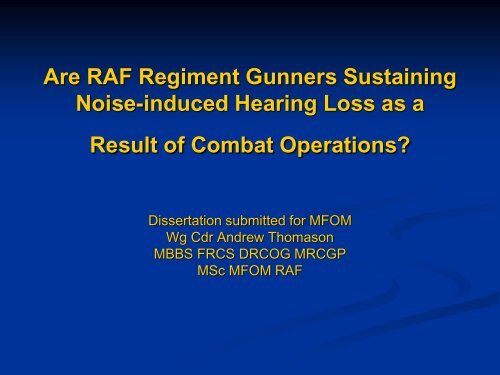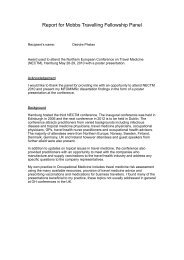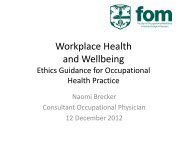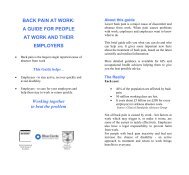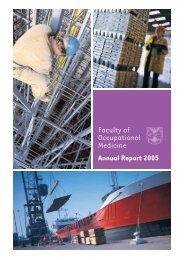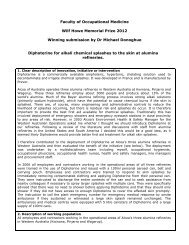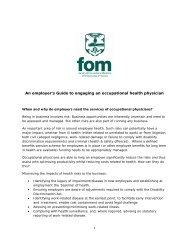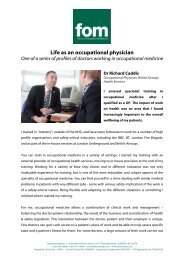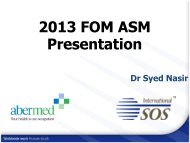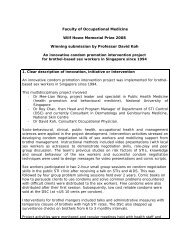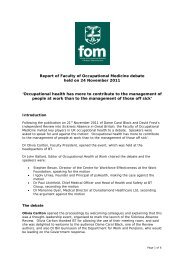Dr Andrew Thomason - Faculty of Occupational Medicine
Dr Andrew Thomason - Faculty of Occupational Medicine
Dr Andrew Thomason - Faculty of Occupational Medicine
Create successful ePaper yourself
Turn your PDF publications into a flip-book with our unique Google optimized e-Paper software.
Are RAF Regiment Gunners Sustaining<br />
Noise-induced Hearing Loss as a<br />
Result <strong>of</strong> Combat Operations?<br />
Dissertation submitted for MFOM<br />
Wg Cdr <strong>Andrew</strong> <strong>Thomason</strong><br />
MBBS FRCS DRCOG MRCGP<br />
MSc MFOM RAF
Scope<br />
• The aim <strong>of</strong> the audit.<br />
• The context. The role <strong>of</strong> RAF Regiment<br />
and patterns <strong>of</strong> noise exposure<br />
• Hearing protection and surveillance.<br />
• The study method.<br />
• The results.<br />
• Conclusion and recommendations.
The Aim<br />
• To audit the occupational hearing loss as<br />
measured by audiometry in RAF Regiment<br />
Gunners since recruitment.<br />
• Who?<br />
• What?<br />
• Where?<br />
• When?<br />
• Why?<br />
• How much?
Who are the RAF Regiment?<br />
• Force Protection: The<br />
aggressive defence <strong>of</strong><br />
RAF assets.<br />
• 7 Field Sqns <strong>of</strong> 150-160<br />
men. On deployment 1 x<br />
Field Sqn to patrol each<br />
airfield.<br />
• Foot and mechanized<br />
patrols, MERT close<br />
support, Joint operations.<br />
• Patrol as 8 man Rifle<br />
Sections.
RAF Regiment Operational Tempo.<br />
• The highest since<br />
WWII.<br />
• Deploying for 6/12<br />
with 12/12 between<br />
• 3/12 predeployment<br />
training (PDT).<br />
• Rifle and Support<br />
Weapons Sections.
What noise exposure on PDT/ Ops?<br />
• Weapon Noise Levels<br />
(Max)<br />
• .50 cal MG 153dB<br />
• SA80 161 dB<br />
• MP5 SMG 158 dB<br />
• GPMG 169 dB<br />
• 81mm mortar 179 dB<br />
• 60mm mortar 185 dB<br />
(Surg Cpt Brown and US Army Center for<br />
Health Promotion and Preventative<br />
<strong>Medicine</strong>)
What noise exposure on PDT/ ops?<br />
• CH-47D Chinook<br />
102dB<br />
• Bulldog APC 96-115<br />
dB<br />
• IEDs 200-300dB
Where and When Might Exposure Occur?<br />
• During PDT.<br />
• Practicing firing and manoeuvring (HP lost<br />
and not replaced or just not worn).<br />
• Providing simulated resistance to house<br />
clearance drills.<br />
• On Combat Operations:<br />
• Enemy contact<br />
• IED detonation<br />
• Transport to the patrol area by helicopter or<br />
ground vehicle.
Hearing protection and surveillance.
Why no earplugs?<br />
• On PDT.<br />
• Inexperience (undeveloped communication/<br />
equipment skills)<br />
• Urban myth (blank rounds are quieter).<br />
• Cultural norms.<br />
• A more resilient population than the average.<br />
• Peer influence (the resilient leading).<br />
• Availability <strong>of</strong> a choice <strong>of</strong> earplugs.
Why no earplugs?<br />
• On Combat Operations:<br />
• Need for situational awareness to survive<br />
enemy contact. Loss <strong>of</strong> directional information<br />
• Unfamiliarity and lack <strong>of</strong> training with new HP.<br />
• Compatibility <strong>of</strong> HP with comms/ the<br />
environment/ length <strong>of</strong> patrol.
Data on Military Hearing Loss<br />
• A few small studies regarding hearing loss in<br />
other country forces.<br />
• No studies <strong>of</strong> prevalence <strong>of</strong> hearing loss in the<br />
RAF Regiment.<br />
• ONS data:<br />
• Since 2000 only 5 Regt Gunners medically<br />
retired for NIHL.<br />
• 39 retired from the Army and 8 from the RN in<br />
a similar time period. (Hansard Jan 2010).<br />
• Corroborated from RAFMB database.
Referrals to OM for NIHL<br />
• Regiment Gunners make up 6-7% <strong>of</strong><br />
Service personnel<br />
• 25% <strong>of</strong> referrals to ROMDs are for<br />
advice on NIHL.<br />
• 69% <strong>of</strong> those referrals are Regiment<br />
Gunners.
The Population Sample.<br />
• The audit ran from the 14th September 2008 to<br />
the 23rd <strong>of</strong> July 2010.<br />
• The Power Study. 120 required to demonstrate a<br />
difference <strong>of</strong> 10 dB to give the study a power <strong>of</strong><br />
0.8.<br />
• Ideally quota sampling <strong>of</strong> the total population <strong>of</strong><br />
Gunners, based on rank and specialist Q.<br />
• Criteria: Member <strong>of</strong> a Regt Fld Sqn and to have<br />
deployed at least once on combat ops.
Participants.<br />
• 51 Field Sqn returned from Iraq Mar 09.<br />
• 15 Field Sqn returned from Afghanistan Jun 09.<br />
• 27 Field Sqn returned from Afghanistan Feb 10.<br />
• 135 Regiment Gunners interviewed.<br />
• 12 were excluded (URTI, wax, recent noise<br />
exposure).<br />
• None refused to participate.<br />
• Total 123 Gunners included.
Audit method.<br />
• Audiogram performed where none available<br />
since last significant noise exposure.<br />
• The completion <strong>of</strong> a questionnaire and interview:<br />
Patterns <strong>of</strong> noise exposure, use <strong>of</strong> hearing<br />
protection, potential confounding factors.<br />
• Review if the RAF Medical Board records for<br />
outcome <strong>of</strong> those seen for hearing loss.<br />
• Analysis <strong>of</strong> results and comparison <strong>of</strong> the<br />
findings against an expected performance<br />
standard.<br />
• Closing the audit loop
Determining Hearing Loss.<br />
• Adjustment for AAHL to recruitment audiogram<br />
to generate expected values using ISO 7029<br />
algorithm
Defining Noise-induced<br />
Hearing Loss<br />
• “When any single measurement <strong>of</strong> hearing<br />
threshold level (HTL) at 3, 4 or 6 kHz is at least<br />
10 dB greater than the HTL at 1 kHz or 2kHz”<br />
(Coles 2000).<br />
• Accompanied a history <strong>of</strong> sufficient noise<br />
exposure (MRC 1986), accompanied by typical<br />
notch/bulge on the audiogram.
Testing for the effect <strong>of</strong><br />
confounding factors.<br />
• Blood group, eye colour, smoking,<br />
handedness, exposure to nonoccupational<br />
noise, family history <strong>of</strong><br />
deafness and childhood ear infection were<br />
tested for influence on hearing loss. None<br />
was shown to contribute significantly.
The Additional Hearing Loss Sustained<br />
Median <strong>of</strong> threshold shift <strong>of</strong> 10 dB, IQR 5 to 15 dB, range <strong>of</strong> 0 to 75 dB.
Testing for a difference in hearing<br />
after combat operations.<br />
• Observed hearing acuity derived from the<br />
summed thresholds for 1 to 6kHz was<br />
significant worse than the expected acuity<br />
derived from the recruitment audiograms<br />
correct for age (p
Degree <strong>of</strong> Hearing Loss<br />
• 88 Gunners (72%) had a threshold shift <strong>of</strong> at<br />
least 10 dB (mild) at 3, 4 or 6 kHz in the worst<br />
ear.<br />
• 19 Gunners (15%) had at least 25 dB shift at 3,<br />
4 or 6 kHz.<br />
• 8 Gunners (7%) had at least 50 dB shift at 3, 4<br />
or 6 kHz (2 <strong>of</strong> >=70 dB).
Where Noise Exposure Occurred<br />
• Of the 123 tested:<br />
• 13 reported exposure only on PDT.<br />
• 47 only on deployment<br />
• 41 on both PDT and deployment<br />
• 22 recalled no significant unprotected<br />
exposure<br />
• 44% <strong>of</strong> Gunners reported significant<br />
unprotected exposure on pre-deployment<br />
training.
Time in Service<br />
and Hearing Loss<br />
• Median time in service was 3 years.<br />
• There was no difference in degree <strong>of</strong><br />
hearing loss if those in 3 years<br />
• ? Healthy worker effect<br />
• ? More effective use <strong>of</strong> HP with time<br />
• ? Promotion away from noise sources.<br />
• ? Type II error.
Auditing the frequency <strong>of</strong><br />
hearing surveillance.<br />
• 44 out <strong>of</strong> the 123 (36%) had not had an<br />
audiogram within the last 24 months<br />
(median 23 month, inter-quartile range 12<br />
to 28 months, range 1 to 91 months).
Discussion<br />
• Bias: Recall and type II when analysing the<br />
contribution <strong>of</strong> confounding factors and time in<br />
service.<br />
• Use <strong>of</strong> HP by the Rifle Flights and the influence<br />
<strong>of</strong> individual susceptibility within a Rifle Flight<br />
• The importance <strong>of</strong> involving the end user in the<br />
introduction <strong>of</strong> new hearing protection systems.<br />
• The significance <strong>of</strong> error in performing and<br />
recording audiometric data on Station Medical<br />
Centres.
Conclusions and<br />
recommendations:<br />
• Pre-deployment training could be a source<br />
<strong>of</strong> potentially avoidable unprotected noise<br />
exposure. Changing habits need to be<br />
supported by change in culture.<br />
• For hearing surveillance to be performed<br />
in a timely and effective manner by Station<br />
Medical Centres there needs to be<br />
provision <strong>of</strong> a sufficient number <strong>of</strong> properly<br />
trained personnel to do so.
Summary<br />
• Regiment Gunners are sustaining noise<br />
induced hearing loss as a result <strong>of</strong> combat<br />
operations.<br />
• Potentially avoidable hearing loss may be<br />
occurring on pre-deployment training.<br />
• The quality <strong>of</strong> equipment is improving<br />
(specifically integrated comms systems).
Mastiff IED strike.<br />
Op Herrick May 2010
Any Questions?


